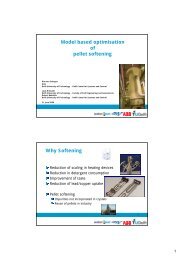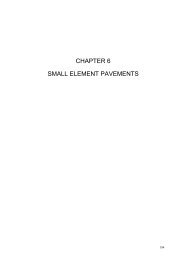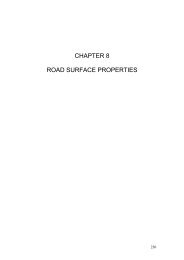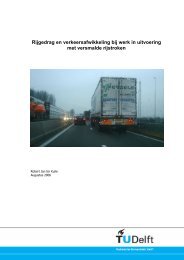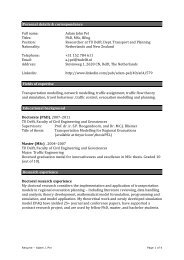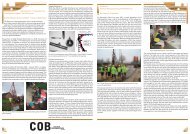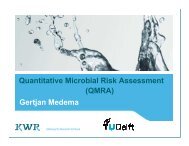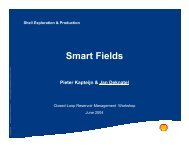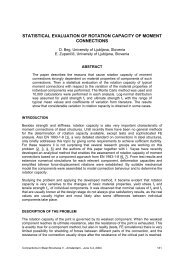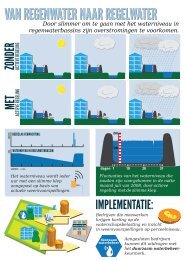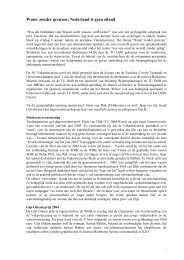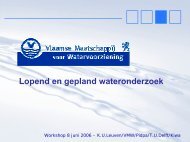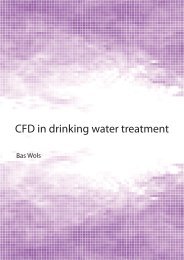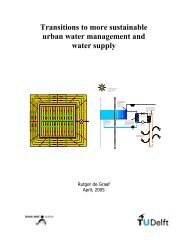Induction heating of electrically conductive porous asphalt ... - TU Delft
Induction heating of electrically conductive porous asphalt ... - TU Delft
Induction heating of electrically conductive porous asphalt ... - TU Delft
You also want an ePaper? Increase the reach of your titles
YUMPU automatically turns print PDFs into web optimized ePapers that Google loves.
ARTICLE IN PRESS<br />
6 Q. Liu et al. / Construction and Building Materials xxx (2010) xxx–xxx<br />
Fig. 9. <strong>Induction</strong> <strong>heating</strong> image <strong>of</strong> a sample with 10% steel wool type 000.<br />
wool results in a decrease <strong>of</strong> the maximum strength <strong>of</strong> <strong>porous</strong> <strong>asphalt</strong><br />
concrete. Steel wool type 000 <strong>of</strong>fers a much weaker reinforcement<br />
than steel fiber type 1. The maximum ITS <strong>of</strong> samples<br />
containing steel wool type 000 happens at around 4% with a value<br />
<strong>of</strong> 2.27 MPa, only slightly higher than the ITS <strong>of</strong> plain samples<br />
without steel wool at a value <strong>of</strong> 2.06 MPa and much lower than<br />
the maximum ITS <strong>of</strong> samples containing about 11% steel fibers at<br />
a value <strong>of</strong> 2.62 MPa. It is very interesting to note that the ITS <strong>of</strong><br />
samples with optimum electrical conductivity containing 10% <strong>of</strong><br />
steel wool type 000 and 20% <strong>of</strong> steel fiber type 1 are 1.99 MPa<br />
and 2.03 MPa, very close to each other. So, steel wool type 000<br />
and steel fiber type 1 have the same effect on the ITS <strong>of</strong> <strong>porous</strong> <strong>asphalt</strong><br />
sample at their respective content for optimal electrical conductivity.<br />
From the point <strong>of</strong> view <strong>of</strong> the electrical conductivity,<br />
steel wool type 000 has better performance than steel fibers.<br />
3.6. <strong>Induction</strong> <strong>heating</strong> <strong>of</strong> <strong>porous</strong> <strong>asphalt</strong> concrete<br />
To study the induction <strong>heating</strong> <strong>of</strong> <strong>porous</strong> <strong>asphalt</strong> concrete, samples<br />
containing steel wool type 000 were used. Fig. 9 shows an<br />
induction <strong>heating</strong> image <strong>of</strong> the sample with 10% steel wool. All<br />
samples have the similar images like this. On the top surface <strong>of</strong><br />
the sample, clusters <strong>of</strong> steel wool work as small heaters. This corresponds<br />
to the shining dots on the surface <strong>of</strong> the sample in Fig. 9.<br />
The image shows uniform temperature in the horizontal direction.<br />
This is because the magnetic field is constant at the same distance<br />
from the coil. The temperature <strong>of</strong> the sample decreases from top to<br />
bottom. It was also found that samples had a higher <strong>heating</strong> rate<br />
when they were closer to the coil <strong>of</strong> the induction machine. The<br />
reason for this is that the magnetic field is stronger close to the<br />
coil. Finding the optimum distance between the pavement and<br />
the coil will be a topic for future study.<br />
The temperatures <strong>of</strong> all the samples with different steel wool<br />
volume contents were recorded and used to analyze the effect <strong>of</strong><br />
the steel wool content on the <strong>heating</strong> rate <strong>of</strong> <strong>porous</strong> <strong>asphalt</strong> samples<br />
(Fig. 10). The plain sample without steel wool was almost not<br />
heated in 3 min because <strong>of</strong> the very low <strong>heating</strong> speed. Below 10%<br />
<strong>of</strong> steel wool in the mixture, the temperature reached increased<br />
with the increase <strong>of</strong> the volume content <strong>of</strong> steel wool. The samples<br />
could be heated, even if hey were not <strong>conductive</strong>, but the <strong>heating</strong><br />
rate was lower. The temperature cannot be increased any more<br />
when the steel wool volume content is above 10%. This value coincides<br />
with the minimum in the resistivity curve in Fig. 8. The minimum<br />
resistivity will result in a maximum Joule heat in the<br />
sample; hence the temperature will be also a maximum. Adding<br />
steel wool above 10% does not improve the <strong>heating</strong> and will result<br />
in a decrease <strong>of</strong> the indirect tensile strength, as shown in Fig. 8. So,<br />
Temperature ºC<br />
160<br />
140<br />
120<br />
100<br />
80<br />
60<br />
40<br />
20<br />
0<br />
10% is the optimal volume content <strong>of</strong> this type <strong>of</strong> steel wool to heat<br />
easily <strong>porous</strong> <strong>asphalt</strong> concrete.<br />
4. Conclusions<br />
30s<br />
90s<br />
150s<br />
0 2 4 6 8 10 12 14 16<br />
Steel wool volume content %<br />
It was found that long steel wool type 000, is better than short<br />
steel fiber type 1 to make <strong>porous</strong> <strong>asphalt</strong> concrete <strong>electrically</strong> <strong>conductive</strong>.<br />
However, short steel fibers have better strength reinforcement<br />
capacity than steel wool. The mechanisms <strong>of</strong> electrical<br />
conductivity and induction <strong>heating</strong> are explained in this paper.<br />
10% (by volume <strong>of</strong> bitumen) <strong>of</strong> steel wool type 000 is proposed<br />
as an ideal content to make <strong>porous</strong> <strong>asphalt</strong> concrete <strong>conductive</strong><br />
and for a fast induction <strong>heating</strong>. Besides, this value gives an acceptable<br />
indirect tensile strength to <strong>porous</strong> <strong>asphalt</strong> concrete. Adding<br />
more bitumen for durability purpose can increase the electrical<br />
conductivity <strong>of</strong> <strong>porous</strong> <strong>asphalt</strong> concrete, but it can also decrease<br />
its indirect tensile strength. It is expected that the self-healing<br />
capacity <strong>of</strong> <strong>asphalt</strong> concrete will be enhanced with the induction<br />
<strong>heating</strong>, although this is a matter for future study.<br />
5. Further research plan<br />
60s<br />
120s<br />
180s<br />
Fig. 10. Effect <strong>of</strong> steel wool type 000 volume content on the <strong>heating</strong> rate <strong>of</strong> <strong>porous</strong><br />
<strong>asphalt</strong> concrete.<br />
It has been proved that the <strong>electrically</strong> <strong>conductive</strong> <strong>porous</strong> <strong>asphalt</strong><br />
concrete can be heated quickly with induction energy. However,<br />
work needs to be done to detect the healing effect <strong>of</strong> this<br />
<strong>porous</strong> <strong>asphalt</strong> concrete. The idea is to introduce some damage<br />
Please cite this article in press as: Liu Q et al. <strong>Induction</strong> <strong>heating</strong> <strong>of</strong> <strong>electrically</strong> <strong>conductive</strong> <strong>porous</strong> <strong>asphalt</strong> concrete. Constr Build Mater (2010), doi:10.1016/<br />
j.conbuildmat.2009.12.019



